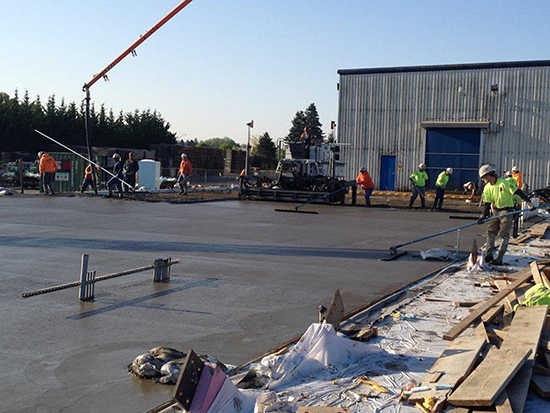|
Subscribe / Renew |
|
|
Contact Us |
|
| ► Subscribe to our Free Weekly Newsletter | |
| home | Welcome, sign in or click here to subscribe. | login |
Construction
| |
 |
May 17, 2013
Special applications: Technical merit
Columbia ColStor

Location: Woodland, Cowlitz County
Owner/developer: Energy Northwest
Project team: PCI Performance Contracting, general contractor; Bradford Conrad Crow Engineering Co., engineer; Whitaker/Ellis Builders, concrete contractor; CalPortland, ready-mix supplier
Columbia ColStor, a cold storage company based in Moses Lake, owns thousands of square feet of concrete slabs, mostly in climate-controlled areas.
The facility that serves the Portland area is located off Interstate 5 in Woodland. It needed more square footage and additional truck docks.
The project added 68,000 square feet of freezer space and just under 15,000 square feet of loading docks. With this addition there is now more than 6.8 million cubic feet of freezer space. The facility now has 30 truck doors and eight rail doors, providing distribution services for the Pacific Northwest and the Pacific Rim.
Products are stored at the facility in areas where temperatures range from minus 20 to 40 degrees. These temperatures can be a challenge to concrete slabs, requiring special engineering of the subgrade.
Another consideration for the slabs is jointing. Constant forklift traffic can make the joints spall, creating a costly maintenance issue, especially in an environment that is not generating revenues unless it is at low temperatures, making any sort of concrete repair very costly and disruptive.
The 8-inch-thick slabs are cast on 16 inches of fill. This fill includes more than 6 inches of rigid insulation and a thick vapor barrier. Under the vapor barrier is a sand bed with a heating system in it. There are also temperature probes in the sand layer that monitor the subgrade. The engineers know that insulation slows cold, but it does not stop it, so to keep the subgrade from freezing and heaving, the heating system is utilized as needed.
The owner brought in the same project team for this addition that he used to build the original structure in 2001. Since they had success with the mixes, they again used the same mix components to achieve low shrinkage and minimize cracking while extending joint spacing. After finishing, the concrete was wet cured for maximum cement hydration. This allowed extended joint spacing up to 25 feet using no rebar and diamond dowels.
Concrete was placed with laser screed, and the finish outperformed the specifications for flat and lever. Extreme flatness keeps maintenance costs lower on forklifts, and is very important when working at the heights inside the freezer section.
Other Stories:
- Shotcrete helps restore a school that went up in flames
- Concrete paving
Martin Luther King Jr. Way phase one - Special applications: Artistic merit / tie
Everett Performing Arts Plaza - Special applications: Artistic merit / tie
East Bay Public Plaza - Pervious concrete
Woods at Golden Given - Architectural/decorative concrete / tie
Lake Washington High School - Residential structures
Lions Gate - Architectural/decorative concrete / tie
St. Martin’s Abbey courtyard - Residential decorative concrete
Sprague residence - Public works: Bridges
Manette Bridge replacement - Public works: Infrastructure
Maple Leaf Reservoir - Cast-in-place structures
Seattle Cancer Care Alliance Proton Therapy - GRAND AWARD/Tilt-up structures
Everett Clinic Smokey Point Medical Center - Renton Memorial Stadium owes its good looks to concrete
- Public renovations
Percival Landing major rehabilitation


